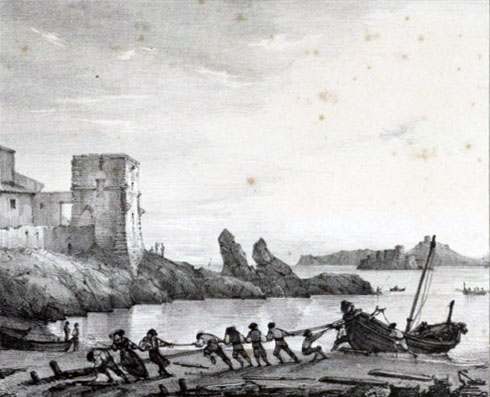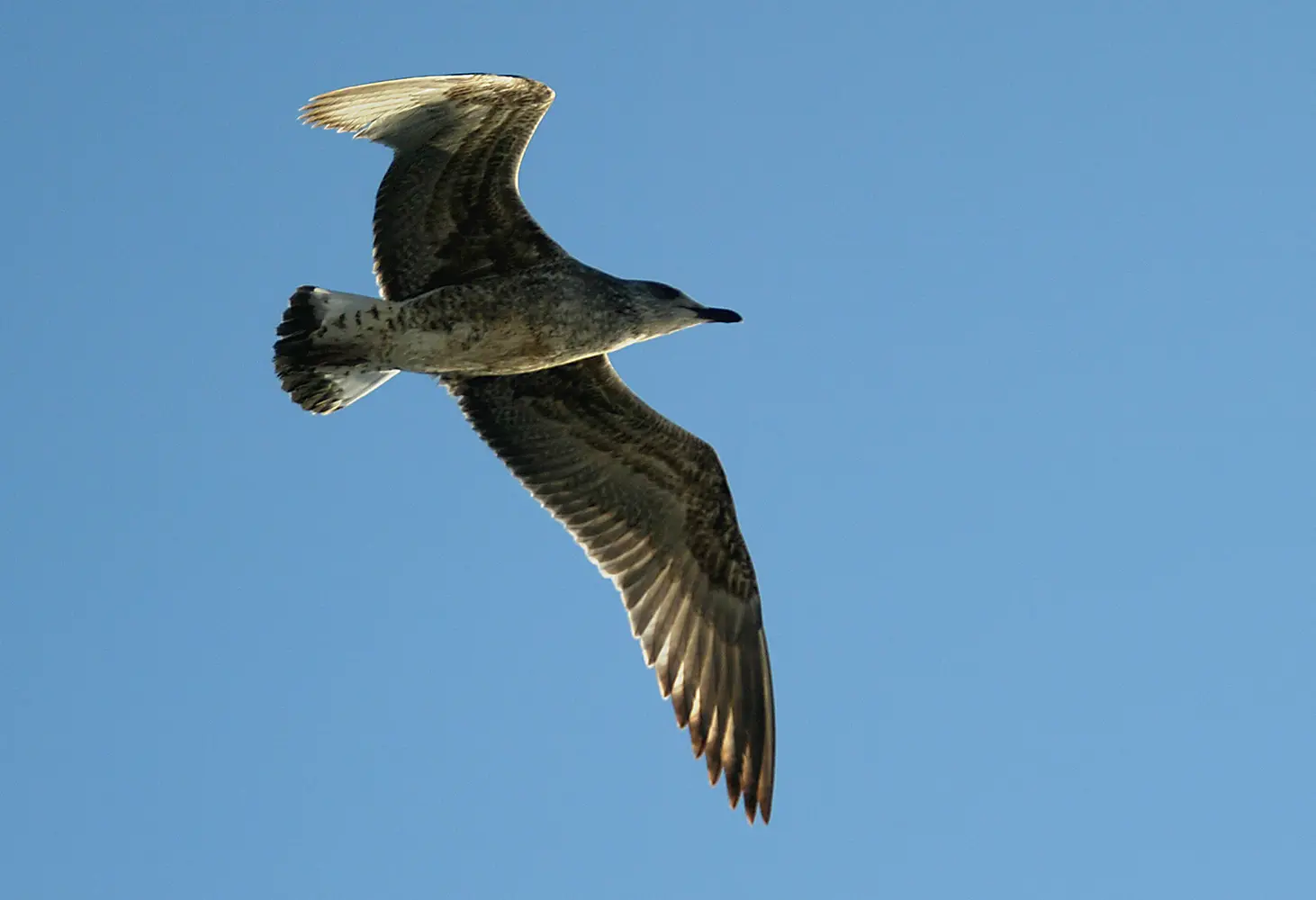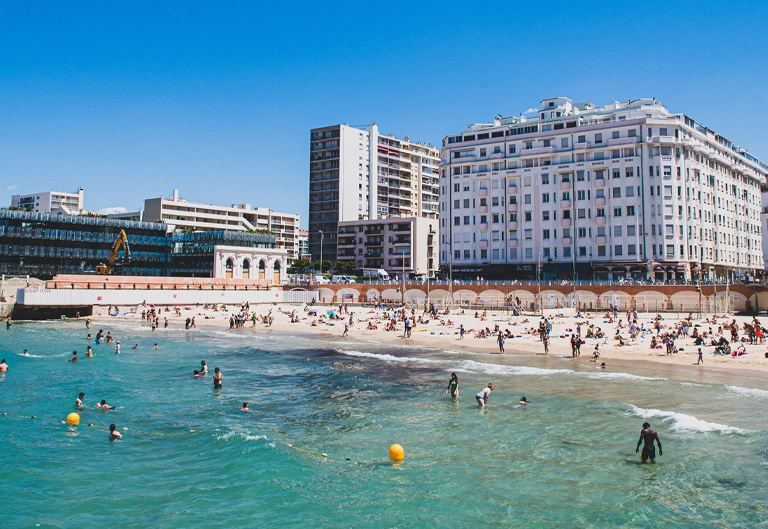Marseille’s Catalans in art
The Catalans neighbourhood and beach, located at the entrance to Marseille’s Old Port, represent a living fragment of the Phocaean city. A place of gathering, work, and leisure, this space has inspired numerous artists, particularly painters and writers, becoming a symbol of the Mediterranean and life in Marseille. Much of the memory of Catalans is preserved in the collections of the Museums of Marseille and in the Archives of the City.
Catalans Beach in literature
Marseille, with its port, coves, and lively neighbourhoods, has always fascinated writers. The Catalans neighbourhood, named after the Catalan fishermen who settled there in the 17th century, embodies a microcosm of this port city.
It was Alexandre Dumas, author of The Count of Monte Cristo, who immortalised the site in French literature. This special connection between the writer and Catalans dates back to the 19th century, when Dumas, fascinated by the Mediterranean and its tales, visited Marseille several times, drawn by its port, its landscapes, and its residents from all corners of the globe. He referred to Marseille in several of his works.
In The Count of Monte Cristo, a significant part of the story takes place in the Phocaean city, notably at the Château d’If, which faces Catalans Beach. Back then, this beach, less visited and bordered by a small fishing village, embodied the Mediterranean charm that so inspired the writer:
“One day a mysterious colony quitted Spain and settled on the tongue of land on which it is to this day. It arrived from no one knew where and spoke an unknown tongue. One of its chiefs, who understood Provençal begged the commune of Marseilles to give them this bare and barren promontory, on which, like the sailors of the ancient time, they had run their boats ashore. The request was granted, and three months afterwards, around the twelve or fifteen small vessels which had brought these gipsies of the sea, a small village sprung up. This village, constructed in a singular and picturesque manner, half Moorish, half Spanish, is that we behold at the present day inhabited by descendants of those men who speak the language of their fathers. For three or four centuries they remained faithful to this small promontory, on which they had settled like a flight of seabirds, without mixing with the Marseillaise population, intermarrying, and preserving their original customs and the costume of their mother country as they have preserved its language. Our readers will follow us along the only street of this little village, and enter with us into one of the houses, on the outside of which sun had stamped that beautiful colour of the dead–leaf peculiar to the buildings of the country, and within a coat of limewash, of that white tint which forms the only ornament of Spanish posadas.” The Count of Monte Cristo, 1st edition. 1845, chap. 3 (“The Catalans”).
Thanks to its success, the novel was adapted into a play in 1848, and later into an opera, a musical, and comic strips across all continents.
Later, other Provençal writers, such as Jean-Claude Izzo in his Marseille trilogy Total Khéops (Total Chaos), and Jean-Pierre Cassely in his work On a volé les chaînes du port (The Chains of the Port Were Stolen), also celebrated the coastal neighbourhoods of Marseille, paying tribute to their authenticity and their deep connection with the sea.
Catalans Beach in paintings and visual arts
The unique light of Marseille has attracted numerous painters, and Catalans Beach with its view of the Frioul Islands, its colourful boats, and beach huts, has been a favoured subject.
Provençal painters such as Paul Guigou, Émile Loubon, André Maglione, Maurice Pauzat, and Jean-Jérôme Baugean, along with other early impressionist artists like Félix Ziem and Louis-Amable Crapelet, often depicted Mediterranean landscapes, including Catalans Cove, capturing the warm tones and maritime contrasts.
Paul Guigou
1834 (Vaucluse) – 1871 (Paris)
A painter and engraver, Paul Guigou trained at the Beaux-Art in Marseille, one of the most original and active art schools in France at the time, led by Émile Loubon, who encouraged his students to embrace landscape painting and painting en plein air. After moving to Paris in 1862, Guigou's works were regularly exhibited at the Salon de Paris from 1863 to 1870. After his death in 1871, his work fell into obscurity for nearly thirty years. It was rediscovered during the French Art Centenary Exhibition of 1900, held as part of the World’s Exhibition in Paris. In the 21st century, some exhibitions, notably in Paris (at the Musée Marmottan Monet in 2004, showcasing 118 of his paintings, watercolours, and drawings) and in Marseille (at the Musée des Beaux-Arts in 2005), helped bring his work to a wider audience. Today, his paintings are housed in several museums in France, including the Musée d'Orsay and the Beaux-Arts de Marseille.

Paul Guigou - C 1271 14 - Musée Cantini / Beaux-Arts - Les Catalans à Marseille - 1869
Félix Ziem
1821 (Beaune) - 1911 (Paris)
Félix Ziem was a French painter of the Barbizon School, renowned for his marine scenes and landscapes of Venice and Constantinople. An Orientalist painter, Félix Ziem is considered one of the forerunners of Impressionism. After studying drawing and architecture at the École des Beaux-arts in Bidon, he joined his brother in Marseille and later opened a drawing school on the Old Port.

Félix François Georges Ziem - AF 784 07 - Musée du Vieux Marseille / Histoire - Les Catalans - 1850

Félix François Georges Ziem - PhGL 3688 08 - Musée Grobet-Labadié / Arts décoratifs - Maisons de pêcheurs aux Catalans
Louis-Amable Crapelet
1822 (Auxerre) - Marseille (1867)
An Orientalist painter and student of the artist Camille Corot, Louis-Amable Crapelet is best known for his landscapes and street scenes inspired by his travels in Egypt and the Middle East. Sensitive to capturing light and the fleeting nature of characters before the Impressionists, Crapelet played with contrast and light effects in his works. He began his career at the Salon de Paris before traveling to Egypt, and then settling in Marseille, where he was appointed theatre decorator and designed the sets for Meyrebeer's opera Le Prophète (1791–1864) and Alexandre Dumas's Gardes Forestiers, with whom he became close. After travelling around some, he died in Marseille in 1867.

Amable Crapelet - SN CPM 395 - Vue des Catalans - 07 - Musée du Vieux Marseille / Histoire
Émile Loubon
1809 (Aix-en-Provence) - 1863 (Marseille)
Émile Charles Joseph Loubon was a French painter known for his Provençal landscapes. In 1845, he was appointed director of the École de dessin in Marseille. A year later, he founded the first Salon du Cercle des Amis des Arts (Circle of Friends of the Arts), which led to an exhibition of French painters featuring 200 paintings, including works by Eugène Delacroix, Camille Corot, and Prosper Marilhat. His work is marked by a desire to capture the contrasting grandeur of the Provençal landscape, its beauty but also its harshness, the harshness of rural life. Through his paintings, one can almost feel the oppressive heat of the sun, which dries the land, making it so powdery that when flocks of animals move through it, they are surrounded by an insidious cloud of dust.

Émile Loubon - 52205 - Plage des Catalans - 05 - Musée d'Archéologie Méditerranéenne / Service Collections
André Maglione
1838-1923
A painter of landscapes and still lifes, André Maglione studied at the Beaux-Art in Marseille, his hometown. He only participated in two Salons, those of 1866 and 1868. In 1867, he founded the Cercle Artistique de Marseille (The Artistic Circle of Marseille) and published a book in 1903 titled Monticelli intime de 1871 à sa mort (Intimate Monticelli from 1871 to his Death), in which he describes the meetings between Paul Cézanne and the painter Adolphe Monticelli. He was a friend of the painter Ziem.

André Maglione - 2007.0.611 - La Tour des Catalans - 07 - Musée du Vieux Marseille / Histoire
Marius Pauzat
1832-1909 (Marseille)
A landscape painter and watercolourist, Marius Pauzat opened a watercolour studio and began exhibiting in the Salons of his hometown, Marseille, organised by the Association of Marseille Artists. He debuted at the Salon de Paris in 1881 and then worked in Aix and Toulon.

Marius Pauzat - C 1666 14 - Musée Cantini / Beaux-Arts - Bord de mer aux environs du Pharo, Catalans - XIXe siècle
Jean-Jérôme Baugean
1764-1819 (Marseille)
A French painter, drawer, and engraver specialised in maritime subjects, Jean-Jérôme Baugean first worked in Marseille and Italy before settling in Paris, where he became the King’s engraver during the Restoration. He participated in the Paris exhibitions from 1806 to 1812.

Les Catalans vers 1800 - Dessin de J.-J. Baugean - Musée du Vieux-Marseille
Beyond painting, Catalans Beach has often served as a backdrop for photographers and filmmakers, drawn by its wide-open views and its emblematic role in local culture. This location has been used in films and TV series, immortalising its warm and local atmosphere.
Catalans and biodiversity
The Catalans underwater trail
On Catalans Beach, there is an underwater trail perfect for a unique free-diving experience. Accessible year-round, this 200-metre-long path is open to everyone, from beginners to snorkelling enthusiasts, allowing them to discover the shallow seabeds.
From 1 June to 30 September, the trail is marked out with large semi-submerged buoys, equipped with handles so bathers can hold on to them and explore the richness of the local flora and fauna, while also learning more about marine life and the history of Catalans Cove.
Just a few metres from the trail, at a depth of 5 metres underwater, art meets the sea, thanks to submerged sculptures from Marseille’s Underwater Museum.
Sandy seabeds
Catalans Cove is a natural beach. The sandy seabeds that make up this area are home to unassuming but diverse fauna.
Flatfish such as sole and the torpedo ray bury themselves in the sediment, leaving only their eyes visible. The greater weever fish and the Bucchich's goby are mimetic and practice homochromy to blend into the surroundings. Red mullets drive out worms by digging through the sand with their barbels. The lyre-shaped gurnard, with its characteristic hooked profile, spreads its pectoral fins like magnificent indigo blue fans to deter predators. The sand steenbras creates real craters where sea bream and wrasse, in search of prey, come to take advantage of the disturbance. Unaware of the threat from above, a shoal of garfish patrols the surface. An innocuous fried egg jellyfish drifts, surrounded by its cohort of saurel. Sea cucumbers, ceriths, and other murexes tirelessly break down organic matter that has settled on the seabed. Amidst the ripple marks, sand undulations created by the waves, the graceful Josephine's moon snail lays its strange spiral-shaped eggs. Bathed in luminous waves of changing colours, a cuttlefish ventures into open territory to surprise the crabs. The comb sea star and the heart urchin wait for nightfall to emerge from the substrate and explore the surroundings, while tube worms like sabellids and fanworms unfurl their long, branchial plumes in the current, resembling extravagant blooming flowers.
Birds

Catalans is visited by many species of birds.
Some, such as yellow-legged gulls and western jackdaws, are present year-round. Others, like black-headed gulls and sandwich terns, are only transitory and can be observed seasonally during their migration.
On calm summer mornings, it's possible to see kingfishers dive from an overhanging rock to catch fish swimming near the surface.
On the backshore, white wagtails nervously wag their long tails and fly back and forth continuously at the water's edge. The common sandpiper searches the sand with its long beak for crustaceans.
In winter, razorbill penguins, which come from northern Europe to hibernate on the Camargue coast, sometimes make incursions and dive beneath the surface like true living torpedoes.
Young European shags also practice underwater fishing before drying off in the sun with their wings spread wide. Further offshore, you might encounter the imposing northern gannet or admire the gliding flight of a Cory’s shearwater, skimming the waves.

